20 Pro Reasons For Choosing Event Transportation Sites
20 Pro Reasons For Choosing Event Transportation Sites
Blog Article
Top 10 Tips To Schedule And Flexibility For Employee Shuttle Transportation
Here are 10 tips for scheduling employee shuttles and flexibility:
1. Assessing employee needs
Examine the needs of your staff. This can be accomplished through surveys or focus groups to find out their preferred times for shuttles, shift patterns, and any specific requirements. Knowing your employees' various requirements is essential to create a the most efficient schedule for the most number of employees as you can.
2. Implement a Flexible Scheduling System
Develop a flexible system of timetables that can be adjusted based on the requirements of employees. Think about offering a variety of shuttle times throughout the day in order to accommodate different work patterns and shifts. For instance, you can offer shuttles in the early morning to accommodate first-shift workers or midday alternatives for flexible schedules, or late-night services for second and third shift employees.
3. Real-time data can be used for adjustments
Use technology to provide real-time data about employee and traffic use. This data will allow you to make a more informed decision on whether to change shuttle times or add more routes. Through analyzing the data about patterns of usage and patterns, you can improve the scheduling process to meet demand efficiently.
4. Create a Reservation System
Consider implementing a system of reservations for shuttle service. This will allow employees to reserve their seats in advance and ensure that there is enough capacity to accommodate demand. A reservation system will let you know high-demand times so that you can alter your schedule accordingly.
5. Information on Schedule Changes
Everyone in the company should be aware of any changes to the schedule of shuttles. To keep employees up-to-date, use multiple communication channels such as emails or intranets for the company. Communication is key to avoiding confusion and allowing employees to plan their commutes.
6. Monitor Peak Usage Time
Monitor shuttle usage to find the peak times for demand. You can use these statistics to guide you in adjusting your schedule so that you can add more shuttles at busy times. By taking proactive steps to address high traffic times, you'll be able to improve the reliability of service for employees and reduce their wait time.
7. Offer On Demand Services
Investigate the possibility of offering shuttle services on demand for employees with diverse timetables. This could involve employing apps that permit employees to book a shuttle at their convenience, ensuring that transportation is readily available whenever they need it. On-demand service may improve flexibility and help employees working irregular hours.
8. Consider Hybrid Models
Utilize hybrid scheduling models that mix fixed route options with flexible options. You might, for example you have fixed routes during peak hours and flexible pickups or drops in off-peak times. This technique can be utilized to increase efficiency in addition to accommodating the different working hours of employees.
9. You can get feedback on your work to improve continuously.
Encourage employees to provide feedback regarding the shuttle schedule as well as the overall experience of transportation. The feedback will be used to pinpoint areas for improvement and adjust the schedule. By involving employees, you will create a greater feeling of ownership for the shuttle service.
10. Examine and adjust for seasonal changes
Be aware of seasonal shifts that can alter the work schedules of employees. Continuously review and modify the schedule of shuttles to accommodate the changes in availability of employees. Flexible scheduling during these times could aid in maintaining high participation levels.
Implementing these suggestions can help companies establish a responsive and efficient scheduling system for employee shuttle transportation making sure that the service is able to meet the demands of employees in order to maximize efficiency and satisfaction. Check out the top rated discover more for employee transportation for blog advice including direct transportation, bus shuttle service, shuttle bus, shuttle services, cheapest transport, shuttle atl, shuttle atl, shuttle service from the airport, shuttle service from the airport, ground transportation and more.
Ten Tips To Assist Determine The Budget And Costs Of Transportation For Corporate Events
Here are ten top suggestions for budget and cost factors to consider when selecting a corporate event transport service.
1. Perform a comprehensive Analysis of Costs
Conduct a thorough cost analysis of every aspect of the services. This includes rental or leasing costs as well fuel expenses, salaries of drivers and maintenance, insurances, and other costs. Knowing the total cost will help you establish an appropriate budget.
2. Budget Framework: Establish a Clear Budget Framework
Establish a clear budgeting plan that specifies how much your organization is willing to invest in transportation. This framework should include all the identified expenses and allow flexibility to accommodate any unanticipated expenses. A budget can guide the decision-making process and ensures that transport costs remain manageable.
3. Explore a variety of transportation options
Think about the various transportation alternatives for your event. These may include vans, shuttles, or ride-sharing service. Analyze the cost of each option, taking into account factors such as capacity, comfort, and convenience. The most affordable option to meet the needs of guests will maximize the budget.
4. Conclude agreements with transportation providers
When choosing a transportation provider, negotiate contracts to secure the most affordable rates. Many transportation companies will offer discounts for large-scale bookings or corporate events. Establishing good relationships with service providers can lead you to receive better rates as well as improved services that will eventually improve your budget.
5. Make a plan for your fuel costs
Costs for fuel are a major element in the cost of transportation. Estimate the number of trips and the distance required to reach the venue. To reduce costs you should try negotiating with the transportation provider for vehicles that are fuel efficient.
6. Include Contingency Funds
A portion of your budget needs to be reserved for unexpected costs. Transportation issues can be unpredictable. They can include car breakdowns, or the need to travel on additional journeys. Contingency funds will ensure that you can address these situations without overspending or compromising quality of service.
7. Group discounts and packages are available.
It is possible to save money by looking for specials or discounts that transport companies offer. There are many businesses that provide discounted rates for large groups and corporate events. This can result in significant savings. Ask about packages that offer additional services at a reduced cost like additional vehicles, or even on-site coordination.
8. Keep track of your expenses and monitor them
Maintain a close watch on all transportation-related expenses throughout the planning and execution phases. Use spreadsheets or budgeting tools to track costs in real-time. Track expenses to identify areas of savings.
9. Gather Feedback to Improve Budgeting
After the event, ask attendees for feedback on their experience with transportation and associated costs. Analyzing feedback can help you gain insights into the effectiveness of the transportation service and informing future budgeting. Recognizing what was successful and what didn't work will help refine the budget for subsequent occasions.
10. The Total Cost Ownership
If you are considering options for transportation, evaluate the total cost of ownership (TCO) for the vehicle. The total cost of ownership (TCO) includes the price of rental or purchase as well as additional ongoing costs like maintenance, insurance and depreciation. Knowing TCO can help you make well-informed decisions to make sure you are balancing the initial cost against longer-term financial implications.
Utilize these strategies to effectively manage costs, and make educated choices regarding the transportation of corporate events. A properly planned budget ensures that transportation is met and is a key element to ensuring event successful. Attendees can focus on their experience instead of worrying about logistics. The organization's reputation is enhanced through proper budgeting and the management of costs shows its dedication to efficiency and ethical behavior. View the best event transportation blog for more tips including transportation management system, us transport, transportation management solutions, transport planning, pace transportation service, transporting buses, pace transportation, services and logistics, transport services near me, logistics web and more.